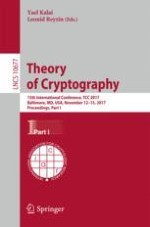2017 | OriginalPaper | Buchkapitel
Functional Encryption for Bounded Collusions, Revisited
verfasst von : Shweta Agrawal, Alon Rosen
Erschienen in: Theory of Cryptography
Aktivieren Sie unsere intelligente Suche, um passende Fachinhalte oder Patente zu finden.
Wählen Sie Textabschnitte aus um mit Künstlicher Intelligenz passenden Patente zu finden. powered by
Markieren Sie Textabschnitte, um KI-gestützt weitere passende Inhalte zu finden. powered by
Abstract
-
Our construction for reusable garbled circuits for \(\mathsf{NC}_1\) achieves the optimal “full” simulation based security.
-
The ciphertext of our scheme can be divided into a succinct data dependent component and a non-succinct data independent component. This makes it well suited for optimization in an online-offline model that allows a majority of the computation to be performed in an offline phase, before the data becomes available.
